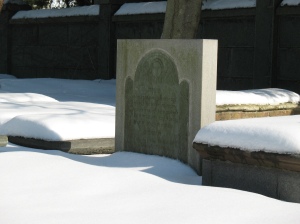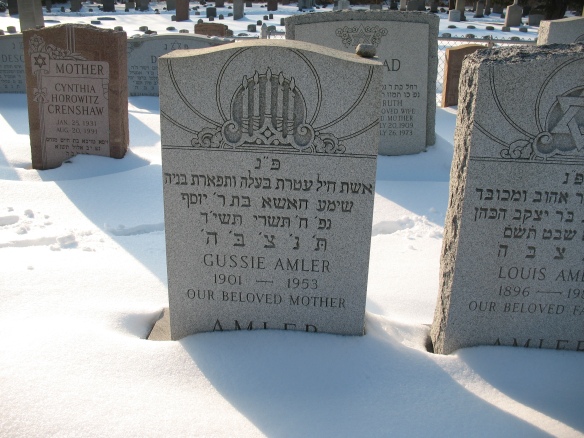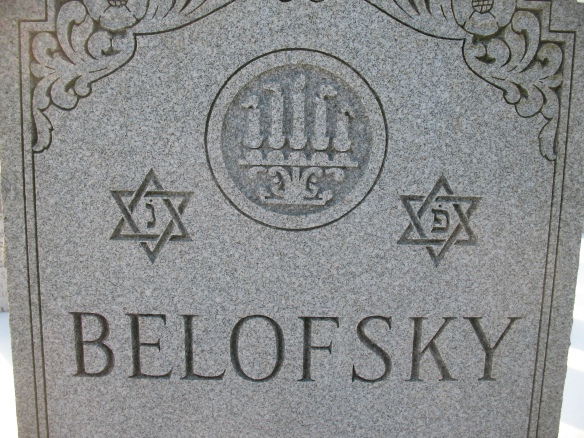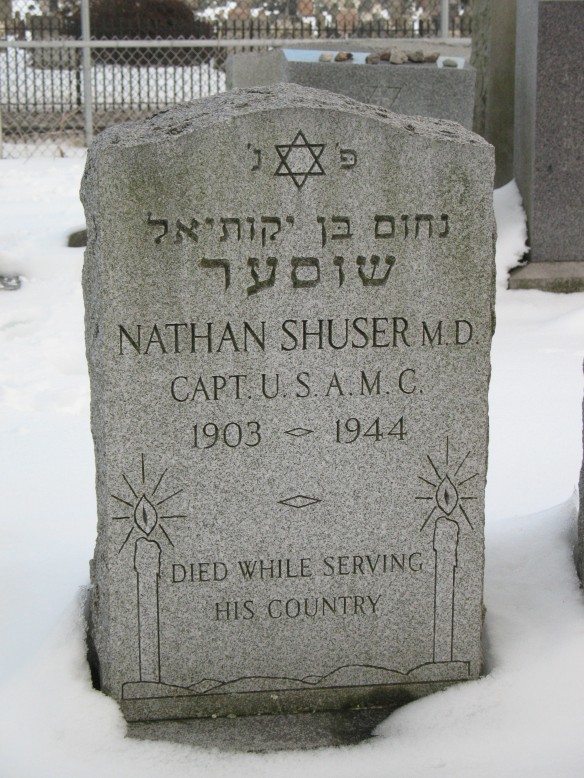I’ve put up a new gallery of photographs of candlesticks in Chmielnik, Poland.
Tag Archives: candlesticks
Candlesticks in Ukrainian Transcarpathia
By Ruth Ellen Gruber
The elegant and informative riowang blog runs a very nice post — with lots of photos — about the Jewish cemetery in Tekovo/Tekehaza in Ukrainian Transcarpathia, which comments in particular on the large number and variety of stones marked by candlesticks.
it is worth noting a special gravestone motif, which almost has its own school in the cemetery of Tekeháza: the large and diverse number of geometric candelabra. The presence of candelabra – as we have already seen in the cemetery of Lesko – is not unique in itself. We meet with them almost only on women’s graves, praising the Friday night candle-lighting and, beyond that, the light and warmth of the family home as well as the virtuous woman maintaining it. What is interesting in Tekeháza, however, is the large number and many variations of stylized, geometric candelabra.
The many photographs on the post show candlesticks that are geometric and braided at the same time, as well as some that look like plants:
Once speaking about the candelabra, it’s worth to point out a special local form of this motif. About these gravestone decorations it is difficult to decide whether they are three-branch candelabra or stylized three-leaved plants
Posting new pictures — from Poland
By Ruth Ellen Gruber
I recently returned from a trip to the far southeastern corner of Poland — that sharp, elongated triangle bordered by Ukraine and Slovakia. I was there, based in the town of Sanok, to write an article about the project to built a replica of the roof and ceiling of the destroyed wooden synagogue in Gwozdziec, now in Ukraine. But I also took the opportunity to visit half a dozen Jewish cemeteries (in Rymanow, Dukla, Sanok, Lutowiska, Baligrod and Lesko) and document the way that candlesticks were used to mark women’s graves. I found several new styles, from very elaborate to simple and not so simple scratched images — no doubt hallmarks of local carvers, and I have begun to post the pictures in the Poland section of the photo galleries.
Here’s a taste:
More thoughts on candlestick typology
By Ruth Ellen Gruber
The basis of this project is the collection of photographs of candlesticks on Jewish tombstones that I myself have taken, in Romania, Ukraine, Poland and elsewhere. These images show a vast range of artistry, skill and invention in the portrayal of the candlestick motif in denoting Jewish women. But they are by no means exhaustive. And, in fact, the more I read and the more I work here at the Hadassah Brandeis Institute thinking and theorizing, the more I simply want to be back in the field, seeking out the stones and documenting the iconography, particularly forms that I failed to photographs on earlier trips.
There is, actually, not very much published material on East European tombstone decoration, and even less about the candles/candlestick/menorah motif used to denote women’s tombs. Scholars have begun to bemoan this. There is, wrote University of Massachusetts professor Aviva Ben Ur, “an academic print culture that regards sculpted stones and cemeteries as largely peripheral […] The historian’s focus on the written word has also meant that stone imagery is at most a secondary consideration. Research on Jewish sepulchres has thus focused on inscriptions, and has been primarily concerned with local community history, genealogy of distinguished members, and linguistic aspects.” (See her article “Still Life: Sephardi, Ashkenazi, and West African Art and Form in Suriname’s Jewish Cemeteries” in American Jewish History, vol 92/1).
This attitude was borne out by the distinguished art historian Moshe Barasch, who in 1988 wrote a memoir article, “Reflection on Tombstones: Childhood Memories,” about the Jewish cemetery in his native Czernowitz (now Cernivtsi) Ukraine. Concerning the “level of artistic achievement” of the stone-carvings, he wrote:
Not too much should be expected. I shall have to describe the artistic character of the monuments as “primitive,” without going into a discussion of what the term means, fully aware that the meaning is far from obvious […] Keeping mind the rather modest quality of these monuments, one’s expectations as to what the free exercise of an artist’s skill may provide in them should not be too high. (article published in Artibus et Historiae, Vol. 9, No. 17 (1988), pp. 127-135)
I of course strongly disagree with Barasch! (And the pictures that go with his article also prove him wrong.) He does admit, though, that one can be “often surprised” by “the variations invented by popular fantasy and executed by anonymous stone carvers.”
In his PhD dissertation (which he very kindly sent me) Boris Khaimovich, of the Center for Jewish Art in Jerusalem, writes deeply and exhaustively about the carving, form and iconography of Jewish tombstones in western Ukraine in the 17th and 18th centuries — a period where some women’s tombstones were marked by candles but before the “boom” in this imagery in the 19th century that made them so commonplace. (One question that intrigues me, in fact, is why the candlestick boom developed? And why, really, only in parts of eastern Europe?)
Boris delves in depth into the meaning of animal and other imagery such as that of birds representing the soul, or heraldic eagles — with one or two heads — representing the absoluteness of heavenly power, or that of a bear holding or pushing through branches, found both men’s and women’s tombs, and believed to symbolize that the deceased was pious or righteous.
But he only mentions candlesticks as women’s markers in passing (if at all) — though the photographs that go with his text clearly show a variety of candlestick, candelabra and menorah motifs, including an 18th century tombstone with hands blessing the candles.
My friend Monika Krajewska’s ground-breaking book A Tribe of Stone, which came out in Poland in 1993, remains one of the most comprehensive discussions of tombstone art in Eastern Europe — though it deals almost exclusively with Poland. Monika and her husband Staszek were early pioneers in seeking out and documenting Jewish cemeteries in Poland; Monika’s earlier book, A Time of Stones, came out in the early 1980s and was one of the first books on a Jewish topic to be published following the loosening of censorship in Poland thanks to the Solidarnosc revolution of 1980.
She describes a wide variety of typology of candlesticks, including braided candelabra which — as I have mentioned in an earlier post — she likens to the braiding of Challah bread (and thus representing two of the three “women’s commandments” at once) but which others describe as a form of the mystical “endless knot” motif. She writes:
“Some stone-cutters produced unusual forms, like a five-branched candelabrum made of snakes, or ones with branches that end with birds’ heads, oak leaves, or imaginary fish which lions’ heads. The foot of the candlestick may also take various shapes, such as an anchor or griphons’ heads. Candelabra made of floral ornaments derive from the mystical concept of the menorah as a Tree of Life, even though the stone masons who rendered such carvings might have been unaware of the association.”
She also notes the many ways that stone-carvers used candles being broken or extinguished as “elaborate death metaphors.”
“These include an eagle shown extinguishing candles with its claws, or a griphon putting out a flame with its beak. The following image is also rare, as well as intriguing: in the center of the relief are candles in candlesticks, some broken and others not; on one or two sides, hands hold new candles and seem to be lighting them from the old ones. Is this an allusion to the handing down of tradition, or of transmitting life itself?”

Gura Humorului, September 2009. Griffins and candlesticks. An extremely elaborate, elegantly carved stone, from 1863, including griffins and floral designs.
Pearl Gruber Kaplan, RIP
By Ruth Ellen Gruber
My Aunt, Pearl Gruber Kaplan, passed away Friday in Santa Barbara, California, at the age of 94. She was my father’s oldest sister; the oldest of my immigrant grandparents’ seven children; a military veteran; a mother; a grandmother and great-grandmother; a highly independent woman who lived her life on her own terms. May her soul be bound up in the bond of life.
I’ve already posted this before, but in 2009, when I was starting this project, I asked Aunt Pearl what her recollections were about her mother (my grandmother) lighting Shabbos candles and what her own relationship with the tradition had been. Pearl, ever iconoclastic, had this to say:
Yes, my mother lit the candles, closed her eyes and said the blessing; then we all sat down to the traditional (and always the same) Friday night dinner of roast chicken. I don’t know whether she continued the ceremony after my father’s death. But I have the candlesticks; and I’ve painted a still-life of the lit candles.
My parents emigrated from Eastern Europe and brought their religious observances, with them. Success,for a man, was measured by his profession and /or income; for a Jewish girl, it was marriage and her role as Queen of the Kitchen. She was the guardian of the various rites and rules of the Orthodox faith, which she observed seriously and zealously. The mother of a friend had four daughters, three of whom (including my friend) were successes, i.e. married. The ‘failure’ was the unmarried administrator of a large hospital in another city. That was then, but the cultural mindset remained pretty much the same until the Conservative and Reformed congregations loosened things up a bit. And of course Betty Friedan, Gloria Steinem, et. al.
Later, my cousin took a photograph of Aunt Pearl, with the candlesticks and the still life she had painted of them.
New Page on Candlestick Typology
I just want to attention anyone reading this blog to a new permanent page I have created called “Candle Types,” on the typology of candlesticks on tombstones.
I have posted representative pictures of various types of candlesticks.
They range from what I would call “classic” Shabbos candles — two matched candles in individual candle-holders — to multi-branched candelabra (including seven-branched menorahs) of various types. Some of them look as if they could have come off of a household’s shelf. Others look like classic Menorahs of antiquity. Many are elaborately ornamental but still look like physical objects. But others still are intricate figures that weave and twist and entwine the branches of the menorah and/or the base of the menorah into fanciful convoluted forms. And some clearly combine the imagery of the Menorah with that of the Tree of Life — or, perhaps, of death, as in some examples the branches of the menorah may look like snakes.
Some stones bear images of hands blessing the flames.
In their fascinating and wonderful book Traditional Jewish Papercuts: An Inner World of Art and Symbol (Hanover NH, 2002), Joseph and Yehudit Shadur write that the intricately convoluted menorah forms appear almost exclusively in two places — in traditional East European Jewish paper cuts (where they are often dominant compositional elements) and on some East European Jewish tombstones. They appear to represent a development of the “endless knot” motif.
The Shadurs write (pp 170-171):
As far as we could ascertain, neither the convoluted menorah configurations nor the endless-knot motif have ever been considered as distinct visual symbols in Jewish iconography. And yet, they are so common and figure so prominently in East-European Jewish papercuts that they can hardly be regarded as mere decorative motifs.
They theorize that
the metamorphosis of the traditional menorah of antiquity and the Middle Ages into the convoluted, endless-knot configurations appearing in the papercuts coincides with the spread and growing popularization of messianic mysticism and the Kabbalah throughout the Jewish communities of Eastern Europe from the early eighteenth century on [.]
In her book A Tribe of Stones, Jewish Cemeteries in Poland (Warsaw 1994) Monika Krajewska, a post-World War II pioneer in the study of gravestone imagery — who is also an accomplished paper-cut artist, likens the twisted menorahs to the braiding of Challah loaves — and in a way, that would mean that the images denote two of the three “women’s commandments” (lighting the Shabbos candles, “taking Challah” or removing a piece of dough when baking bread, and Niddah, or keeping menstrual purity).
Candlesticks in Rhode Island (and a non-candlesticked woman of valor)
By Ruth Ellen Gruber
Over the weekend, I visited friends in Rhode Island who took me to look at several Jewish cemeteries. I was interested in seeing whether, and if so how, the iconography of candlesticks marking the graves of women was found in America as well as eastern and central Europe. I had wanted to visit the old Jewish cemetery in Newport, near the historic Touro Synagogue (the oldest synagogue in the United States), but this was closed — and in any case, the stones were mostly covered by the thick layer of snow that still lies on the ground after many heavy snowfalls over the past few weeks. I was able only to photograph, at a distance, one stone — which bears carved decoration very similar to that found on the famous Colonial period Christian tombstones — an angel head with wings — over a Hebrew epitaph.
There is another, much later, Jewish cemetery in Newport, though, occupying three fenced-off sections in a big municipal cemetery on aptly named “Farewell Street,” and here I found quite a few women’s gravestones bearing the decorative element of candlesticks. The carving was mostly quite simple and rather standardized, though some were slightly more elaborate.
One tombstone was notable for the way the candles were depicted as flickering, or seeming to be on the verge of flickering out — you find a variation of this motif in Eastern Europe, but with the flames pointing to the center of the candelabra, not to the outside.
Also interesting (at least to me!) were the couple of tombstone of MEN that employed the candlestick imagery — like the one below, of a Nathan Shuser, a Jewish medical officer killed in World War II.
The most fascinating tombstone to me, however, was the gravestone of Eva (or Hava) Segal, wife of Dov Mordechai Segal, which did NOT bear the candlestick imagery. In fact, it bore a carved motif that I had never seen before — a loaf of bread, with slices cut from it on a plate, and a neatly aligned knife and fork. No candlesticks in sight. To me, the image could symbolize one of several things.
It could refer to the Seudat Havra-ah, the first meal that mourners are served when they come home from the cemetery to start the shiva mourning period. Bread is generally part of this meal — as are eggs. Or it could illustrated that Mrs. Segal was generous (by showing food offered to be eaten.)
But — and this is what I like to think it represents — it could somehow be a pictorial representation of the “women’s commandment” of “taking Challah,” that is, burning a piece of dough when baking bread. (See in the “articles” section of this web site the article “A Mystery on the Tombstones.”)
As I have noted elsewhere, one of the reasons that candlesticks are used to represent women appears to be the fact that lighting the Sabbath candles is the only one of the three “women’s commandments” that lends itself to easy visual representation — in addition to lighting candles and taking Challah, the third commandment is Niddah, or observing the laws of menstrual purity.
The epitaph does not shed direct light on this — though it praises her generosity. It reads: “A woman of valor; the crown of her husband, has mercy on the poor and guests in her home and acts well and honestly. [She] guided her sons on a straight path.”
Hanukkah Menorahs — a different kind of candlestick

Makeshift Hanukkah menorah on the bar of the Siraly cafe in Budapest, Hanukkah 2009. Photo (c) Ruth Ellen Gruber
By Ruth Ellen Gruber
In Tablet Magazine, editor Alana Newhouse recently wrote about the variety of Hanukkah menorahs, the eight-branched (or nine, if you count the Shammas) candelabras lit for the Hanukkah holiday — one candle a night, with increasing candles until on the last night all eight are lit.
Throughout the vagaries of my connection to religion, I’ve never once had doubts about my connection to its material culture—the challah knives, washing cups, mezuzahs, etc., of Jewish life. Of this stuff, and it is stuff, none has been more alluring for me than our various candle holders. That these pieces occupy the particularly female realm of our religious universe is relevant, but that the point of these accoutrements is to hold fire is even more so. The Hebrew word shamayim—the heavens —is comprised of two words: aish, or fire, and mayim, which means water. As rabbi Shlomo Riskin, among others, has noted: “[While] fire has the ability to bring warmth, it can also devour and destroy. … [C]loud and fire—the lack of clarity expressed by a cloud and the inability to gaze directly into a flame—likewise express one of the deepest truths of the Jewish message: religion is not so much paradise as it is paradox. God demands fealty even in the face of agonizing questions and disturbing uncertainty.”
Sabbath candles certainly fit the bill, as they demand our weekly attention to the challenge of this uncertainty. But what of the chanukiah, the nine-armed fire-holder that represents, in addition to Judaism’s essential paradox, the assertion of a miracle—an alleged interruption into our earthly landscape by the Divine? And here we are, back at the original problem: God.
When I was a kid, the Hanukkia was the only “menorah” I knew — I didn’t realize that there was another, seven-branched menorah which was the more general Jewish (and Israeli) symbol.
Some of the candlesticks depicted on Jewish women’s tombstone resemble these candelabras, but actually represent the Sabbath (and holiday) lights.
Candlesticks in Piotrkow Trybunalski
Candlesticks in my mother’s self-portrait
In one of the several self-portraits my mother, the artist Shirley Moskowitz, drew or painted, she used collage material to enhance a print and tell autobiographical stories. The materials include old photographs of her family, snippets of old paintings and drawings, writings and other imagery evoking the memories of a lifetime. Prominent among them is the representation of Sabbath candles in silver candlesticks, placed on a white tablecloth. The image is slightly surprising, as I don’t recall ever seeing Mom light the candles on a Friday night — but she grew up in a home where they were part of the Shabbos routine, and many of the snapshots used in the collage date from those early years.















